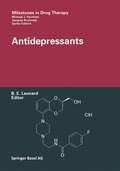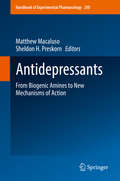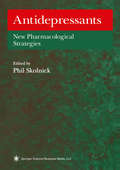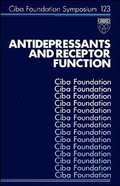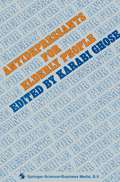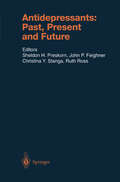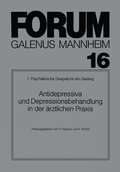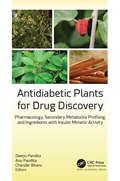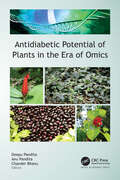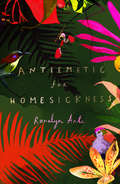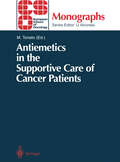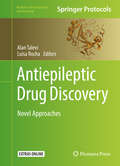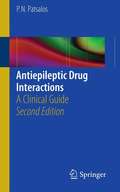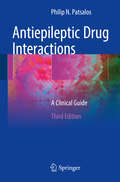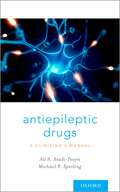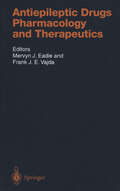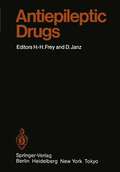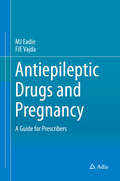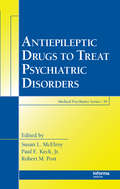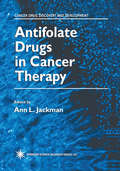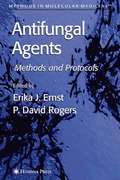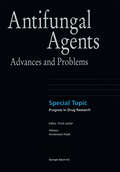- Table View
- List View
Antidepressants (Milestones in Drug Therapy)
by Brian E. LeonardImportant clinical issues as the outcome of long term treatment with antidepressants, the time of onset of the antidepressant response and the limitations of the antidepressants currently available are covered in this monograph. Leading researchers in the area of clinical and experimental psychopharmacology critically assess the progress in their specialist fields. The mechanisms of action of antidepressants are considered, followed by clinical research into the role of the hypothalamic-pituitary-adrenal axis and the immune system in the biology of depression and in response to treatment. The final chapter deals with the important chemical entities now undergoing development as antidepressants. The purpose of this monograph is not only to inform but also to stimulate research into the biology of depression and the mechanisms behind the action of effective antidepressants. This monograph is of interest to psychiatrists, psychologists, pharmacologists, neuroscientists and endocrinologists.
Antidepressants: From Biogenic Amine To New Mechanisms Of Action (Handbook of Experimental Pharmacology #250)
by Matthew Macaluso Sheldon H. PreskornThis volume reviews the known neurobiology of depression and combines classic data on antidepressant treatments with modern theory on the physiology of depression. It also discusses novel mechanism of action drugs.
Antidepressants: New Pharmacological Strategies (Contemporary Neuroscience)
by Phil SkolnickIn this book, leading-edge investigators offer effective strategies to improve current antidepressive therapies and suggest molecular, biological, and genetic approaches that will lead to the development of novel antidepressants. The contributors' critical reviews and commentaries illuminate our understanding of the mechanism(s) responsible for antidepressant action. The book's goal is to move beyond current biogenic amine-based concepts and therapies to the development of new and improved antidepressants that are more effective and have a more rapid onset than current.
Antidepressants and Receptor Function (Novartis Foundation Symposia #123)
by Gregory R. Bock Sarah Clark Ruth PorterCiba Foundation Symposium 123 Antidepressants and Receptor FunctionChairman: Dennis Murphy, 1986 Depression is a common and often debilitating affective disorder. Attempts to develop effective antidepressants have a long history, but many questions remain about the mechanisms of action of such treatments and about the aetiology and pathophysiology of depression itself. Early observations centred attention on central monoamine systems, and animal studies suggested that changes in beta-adrenoceptor responsiveness were a common effect of antidepressant therapies. More recent research has encompassed many different central and peripheral receptors, time-dependent adaptational events at synapses, and the functional significance of changes in neurotransmitter systems in both humans and experimental animals. Such pharmacological studies aimed ultimately at elucidating the neurochemical basis of depression and of promoting new therapeutic approaches, provide the focus of this symposium volume. Many different methods of investigating the links between monoamine systems, depression and antidepressant treatments are described. Recent studies of receptors and of monoamine uptake sites in the brain and the periphery (e.g. in platelets and fibroblasts) are reviewed, with emphasis on alpha and beta adrenoceptors, [3H]imipramine-binding sites and serotonin receptors. The results of monitoring amine metabolites in cerebrospinal fluid and of measuring neuroendocrine, physiological and behavioural responses to pharmacological challenge are presented, providing information on monoaminergic function in depressed patients and experimental animals before, during and after treatment with antidepressant drugs or electroconvulsive shock. Genetic influences on receptor density are also discussed, as is the relevance to human depressive illness of animal models, including stress-induced behavioural depression in rats and responses to social stressors in rhesus monkeys. This book should be of interest to neuropharmacologists, psychopharmacologists, clinical pharmacologists, behavioural scientists, psychiatrists and neuroscientists.
Antidepressants for Elderly People
by K. GhoseDepression is one of the commonest problems in old age. Yet until recently, old people were systematically exduded from participating in drug trials and similar investigations. As a result, knowledge regarding incidence, natural history and management of depression in the elderly are somewhat limited. It is now well-established that old people are sensitive to most psychotropic drugs and they tend to suffer from adverse effects and side effects of antidepressant drugs more frequently than any other age group. These are considered to be due to age-related physiological changes. In addition, because of the frequent association with multiple pathology, the elderly are likely to receive polypharmacy which further complicates the management of antidepressant drug therapy. The aim of this book is to provide a comprehensive guidance on the drug therapy of depression for the dinicians involved in the health care of the elderly. In the first section, epidemiology, presentations and assessment of depression in old age and neuroendocrine abnormalities observed in patients with depression are briefly discussed. However, it mainly deals with the problems of antidepressant drug therapy, such as which antidepressant to prescribe, how to monitor efficacy and side effects, what is the adequate dose, how long to treat a single episode of depression and who requires long term medication. Information regarding pharmacology, side effects, adverse effects, drug interaction and pharmacokinetics of most currently available drugs are provided. Special emphasis has been given on continuation therapy and the choice of an antidepressant drug and their long term safety.
Antidepressants: Past, Present and Future (Handbook of Experimental Pharmacology #157)
by Sheldon H. Preskorn Christina Y. Stanga John P. Feighner Ruth RossA comprehensive review of the current status of antidepressants - how we arrived at this point in their evolution and where we are going in both the near and the long term. It employs both a scientific and historical approach to accomplish these goals. This volume is intended for practitioners who use antidepressants on a daily basis in their practice as well as for the student and researcher. Each will find that it provides a comprehensive and logical approach to this important group of medications. This book is being published as we mark the end of the first 50 years of the modern antidepressant era.
Antidepressiva und Depressionsbehandlung in der ärztlichen Praxis
by V. Beck M. Berger L. Demisch M. Gastpar B. Geiselmann H. Hippius G. Laakmann G. Laux M. Ortner M. Philipp A. Rothenberger E. Rüther G. Schüssler M. WiegandAntidiabetic Plants for Drug Discovery: Pharmacology, Secondary Metabolite Profiling, and Ingredients with Insulin Mimetic Activity
by Deepu Pandita Anu Pandita Chander BhanuThis volume takes an in-depth look at the potential pharmacological applications of 11 important antidiabetic plants, examining their antihyperglycemic, hypoglycemic, and anti-lipidemic properties along with current genome editing research perspectives. Plant natural products, or phytoconstituents, are promising candidates for antidiabetic pharmacological actions. The phytoconstituents, such as fl avonoids, terpenoids, saponins, carotenoids, alkaloids and glycosides, play vital roles in the current and future potent antidiabetic drug development programs Each chapter reviews a particular plant with antidiabetic properties, explaining the therapeutic aspects, its active antidiabetic compounds, and relevant genome editing technology. The specific plants discussed include Azadirachta indica (commonly known as neem, nimtree or Indian lilac), Gymnema sylvestre (commonly called gymnema, Australian cowplant, and Periploca of the woods), Syzygium cumini (commonly known as Malabar plum, Java plum, black plum, jamun or jambolana), Ceylon cinnamon (or true cinnamon, as opposed to cassia cinnamon), insulin plant (or Costus pictus), Trigonella foenum-graecum (better known as fenugreek), Mulberry, Nigella sativa L. (black caraway, also known as black cumin, nigella, kalojeera, kalonji or kalanji), Aegle marmelos (L.) (commonly known as bael (or bili or bhel), also Bengal quince, golden apple, Japanese bitter orange, stone apple or wood apple), Ficus benghalensis (the banyan, banyan fig and Indian banyan), and of course, garlic (Allium sativum). Antidiabetic Plants for Drug Discovery: Pharmacology, Secondary Metabolite Profiling, and Ingredients with Insulin Mimetic Activity will serve as a valuable source of information for students, drug researchers, medical practitioners, diabetic patients, and many others in the effort to gain understand of how these plant drug molecules can help fight diabetes.
Antidiabetic Plants for Drug Discovery: Pharmacology, Secondary Metabolite Profiling, and Ingredients with Insulin Mimetic Activity
by Deepu Pandita Anu Pandita Chander BhanuThis volume takes an in-depth look at the potential pharmacological applications of 11 important antidiabetic plants, examining their antihyperglycemic, hypoglycemic, and anti-lipidemic properties along with current genome editing research perspectives. Plant natural products, or phytoconstituents, are promising candidates for antidiabetic pharmacological actions. The phytoconstituents, such as fl avonoids, terpenoids, saponins, carotenoids, alkaloids and glycosides, play vital roles in the current and future potent antidiabetic drug development programs Each chapter reviews a particular plant with antidiabetic properties, explaining the therapeutic aspects, its active antidiabetic compounds, and relevant genome editing technology. The specific plants discussed include Azadirachta indica (commonly known as neem, nimtree or Indian lilac), Gymnema sylvestre (commonly called gymnema, Australian cowplant, and Periploca of the woods), Syzygium cumini (commonly known as Malabar plum, Java plum, black plum, jamun or jambolana), Ceylon cinnamon (or true cinnamon, as opposed to cassia cinnamon), insulin plant (or Costus pictus), Trigonella foenum-graecum (better known as fenugreek), Mulberry, Nigella sativa L. (black caraway, also known as black cumin, nigella, kalojeera, kalonji or kalanji), Aegle marmelos (L.) (commonly known as bael (or bili or bhel), also Bengal quince, golden apple, Japanese bitter orange, stone apple or wood apple), Ficus benghalensis (the banyan, banyan fig and Indian banyan), and of course, garlic (Allium sativum). Antidiabetic Plants for Drug Discovery: Pharmacology, Secondary Metabolite Profiling, and Ingredients with Insulin Mimetic Activity will serve as a valuable source of information for students, drug researchers, medical practitioners, diabetic patients, and many others in the effort to gain understand of how these plant drug molecules can help fight diabetes.
Antidiabetic Potential of Plants in the Era of Omics
by Deepu Pandita Anu Pandita Chander BhanuHere is an informative overview of diabetes mellitus in conjunction with plant-based treatments. It discusses available methods for studying the antidiabetic activities of scientifically developed plant products, mechanisms of action, their therapeutic superiority, and current genome editing research perspectives and biotechnological approaches. The book begins with an introduction to diabetes, giving a brief overview of the history, diagnosis, classification, pathophysiology, and risk factors. It goes on to review traditional uses of plants for diabetes along with ethnobotanical information. The results of scientific studies on the various modes of action of antidiabetic plants are discussed, such as the molecular aspects of active plantbased antidiabetic drug molecules. A section featuring recent biotechnological advancements of antidiabetic plants and plant-based antidiabetic drugs covers advances in molecular breeding and application of molecular markers, biotechnologically engineered transgenic medicinal plants, and advances in genomic editing tools and techniques.
Antidiabetic Potential of Plants in the Era of Omics
by Deepu Pandita Anu Pandita Chander BhanuHere is an informative overview of diabetes mellitus in conjunction with plant-based treatments. It discusses available methods for studying the antidiabetic activities of scientifically developed plant products, mechanisms of action, their therapeutic superiority, and current genome editing research perspectives and biotechnological approaches. The book begins with an introduction to diabetes, giving a brief overview of the history, diagnosis, classification, pathophysiology, and risk factors. It goes on to review traditional uses of plants for diabetes along with ethnobotanical information. The results of scientific studies on the various modes of action of antidiabetic plants are discussed, such as the molecular aspects of active plantbased antidiabetic drug molecules. A section featuring recent biotechnological advancements of antidiabetic plants and plant-based antidiabetic drugs covers advances in molecular breeding and application of molecular markers, biotechnologically engineered transgenic medicinal plants, and advances in genomic editing tools and techniques.
Antiemetic for Homesickness
by Romalyn Ante'A day will come when you won't missthe country na nagluwal sa 'yo.'- 'Antiemetic for Homesickness'The poems in Romalyn Ante's luminous debut build a bridge between two worlds: journeying from the country 'na nagluwal sa 'yo' - that gave birth to you - to a new life in the United Kingdom. Steeped in the richness of Filipino folklore, and studded with Tagalog, these poems speak of the ache of assimilation and the complexities of belonging, telling the stories of generations of migrants who find exile through employment - through the voices of the mothers who leave and the children who are left behind. With dazzling formal dexterity and emotional resonance, this expansive debut offers a unique perspective on family, colonialism, homeland and heritage: from the countries we carry with us, to the places we call home.'Moving, witty and agile' Observer
Antiemetics in the Supportive Care of Cancer Patients (ESO Monographs)
by Maurizio TonatoMuch progress has been made in the treatment of emesis caused by antineoplastic therapy, and particularly chemotherapy. However, some aspects remain controversial and the subject of continued research. This completely updated comprehensive manual on antiemetics covers a wide range of clinically relevant topics, providing the reader with a good source of easy consultation, and giving an overall picture of the state of the art and some clues for future development.
Antiepileptic Drug Discovery: Novel Approaches (Methods in Pharmacology and Toxicology)
by Alan Talevi and Luisa RochaThis thorough volume delves into antiepileptic drug discovery with a comprehensive collection of innovative approaches for the development of antiepileptic therapies, focusing on novel molecular targets for antiepileptic drugs, computer-aided approaches for the identification of new drug candidates, and therapeutic strategies to overcome refractory epilepsy. The last section illustrates the potential benefits that network pharmacology and rational drug repurposing could bring to the antiepileptic drug discovery community. Written for the Methods in Pharmacology and Toxicology series, chapters include the kind of detailed description and implementation advice to ensure results in the laboratory. Authoritative and practical, Antiepileptic Drug Discovery: Novel Approaches aims to provide medicinal chemists, pharmacologists, and other researchers with the tools need to further explore the study of pharmacoresistant epilepsy and the discovery of new antiepileptic drugs.
Antiepileptic Drug Interactions: A Clinical Guide
by Philip PatsalosAntiepileptic Drug Interactions: A Clinical Guide, Second Edition provides a pocket-sized, systematic description of the most clinically relevant drug interactions that occur between AEDs and also between AEDs and non-AEDs. AEDs are presented alphabetically and by drug class in three sections for easy access: Drug interactions between AEDs; Drug interactions between AEDs and non-AEDs: Interactions affecting AEDs; and Drug interactions between AEDs and non-AEDs: Interactions affected by AEDs. Antiepileptic Drug Interactions: A Clinical Guide, Second Edition should help physicians make more rational choices when polytherapy regimens are indicated and should be of interest to all who treat patients with epilepsy: neurologists and neurosurgeons, trainees at all levels, general practitioners and epilepsy nurse specialists.
Antiepileptic Drug Interactions: A Clinical Guide
by Philip N. PatsalosThis updated third edition of a successful book is a description of both pharmacokinetic and pharmacodynamic antiepileptic drug (AED) interactions, including details of the magnitude and mechanism of interactions, and also of drug combinations that are not associated with interactions and therefore can be coprescribed without undue concern. Presented in alphabetical order and by drug class, drug interactions that occur between AEDs and also between AEDs and non-AEDs are described in three sections: Drug interactions between AEDs; Drug interactions between AEDs and non-AED Drugs: Interactions affecting AEDs; Drug interactions between AEDs and non-AED Drugs: Interactions affected by AEDs.Antiepileptic Drug Interactions: A Clinical Guide, 3rd Edition with its clear, concise and unambiguous content will allow physicians and allied health professionals to make more rational choices when AED polytherapy regimens are indicated. There is always a choice and avoiding highly interacting drugs and choosing drug combinations that are minimally interacting or do not interact should be the goal in treating patients with epilepsy. This book provides all the necessary information so as to allow this goal to be achieved and, if necessary, to aid effective management of AED interactions.
Antiepileptic Drugs: A Clinician's Manual
by Ali A. Asadi-Pooya Michael R SperlingThis concise handbook provides practical, up-to-date clinical guidance on effective selection, prescription, and usage of antiepileptic drugs for patients with epilepsy in various medical conditions and in a variety of clinical contexts. This text discusses choosing drugs when faced with various medical comorbidities; how to correctly prescribe, titrate, and taper drugs; how to monitor drug efficacy and side effects; how to diagnose and manage toxicity; how antiepileptic drugs interact with other medications; and comprehensive coverage of current treatment options. Key Feature of this Manual Include · A brief formal discussion of the basic pharmacology of each antiepileptic drug, with an emphasis on how to select and use anti-epileptic drugs in a variety of clinical contexts. · Discussions of antiepileptic drugs approved for epilepsy since 2009. · New research about already existing antiepileptic drugs. · References for further reading that are oriented toward utility in clinical practice. Antiepileptic Drugs: A Clinician's Manual fills an unmet need as a practical, patient-oriented reference and leads to improved patient care. Supported by practical, clinical knowledge and experience, this is the perfect guide for physicians looking to ensure safe practices in antiepileptic drug therapy.
Antiepileptic Drugs: A Clinician's Manual
by Ali A. Asadi-Pooya Michael R SperlingThis concise handbook provides practical, up-to-date clinical guidance on effective selection, prescription, and usage of antiepileptic drugs for patients with epilepsy in various medical conditions and in a variety of clinical contexts. This text discusses choosing drugs when faced with various medical comorbidities; how to correctly prescribe, titrate, and taper drugs; how to monitor drug efficacy and side effects; how to diagnose and manage toxicity; how antiepileptic drugs interact with other medications; and comprehensive coverage of current treatment options. Key Feature of this Manual Include · A brief formal discussion of the basic pharmacology of each antiepileptic drug, with an emphasis on how to select and use anti-epileptic drugs in a variety of clinical contexts. · Discussions of antiepileptic drugs approved for epilepsy since 2009. · New research about already existing antiepileptic drugs. · References for further reading that are oriented toward utility in clinical practice. Antiepileptic Drugs: A Clinician's Manual fills an unmet need as a practical, patient-oriented reference and leads to improved patient care. Supported by practical, clinical knowledge and experience, this is the perfect guide for physicians looking to ensure safe practices in antiepileptic drug therapy.
Antiepileptic Drugs: Pharmacology and Therapeutics (Handbook of Experimental Pharmacology #138)
by M. J. Eadie F. VajdaIn 1985, volume 74 of the Springer-Verlag Handbook of Experimental Phar macology, under the editorship of H. -H. Frey and D. Janz, appeared. In this volume the then available data on the topic of antiepileptic drugs were col lated and analysed. Over the intervening years knowledge in this area has grown progressively. More new antiepileptic drugs than the total number of agents that were in common use 15 years ago have in the interval either come on to the market or are about to do so. As well, further agents are at a fairly advanced stage of development, whilst the already established drugs have by and large held their places in clinical practice. Knowledge of epileptogenesis has advanced considerably. The mechanisms of action of antiepileptic drugs at the molecular level and in various animal models of epileptic seizures and of the epileptic state are much better understood than they were previously. As well, more information is available concerning the natural history of human epilepsy, and this knowledge is important in making optimal use of the various agents that are now available. Therefore, it has seemed appropriate at this stage in the evolution of knowledge to produce a second volume dealing with Antiepileptic Drugs in the Handbook of Experimental Pharmacology series.
Antiepileptic Drugs (Handbook of Experimental Pharmacology #74)
by Hans-Hasso Frey D. JanzEpileptic disorders need treatment for many years or even for life, and this makes a thorough understanding of the pharmacokinetics and possible hazards and side effects of the drugs used in treatment mandatory. During recent decades our knowledge in this field has considerably increased, not least as a result of the development of specific and sensitive methods for the determination of anti epileptic agents in biological material. The clinical pharmacology of this group of drugs has been studied extensively and can today be regarded as well established. This does not necessarily mean that drug treatment of epilepsy is without problems. For example, it has recently been shown that one of the newer anti epileptic drugs, greeted with great enthusiasm by clinicians, may in rare instances induce serious damage to the liver and the pancreas, and seems even to have a certain teratogenic potential. Clinical problems should be understood as a challenge to the experimental pharmacologist, who should try to find explanations for the clinical hazards, and, if possible, show new ways in which better drugs might be developed. In recent years interest has focused on the importance of the inhibitory transmitter 'l'-aminobutyric acid (GABA) in the pathophysiology of epilepsy, and there have been a series of attempts to find useful antiepileptic drugs among substances interfering with GABA metabolism in the CNS.
Antiepileptic Drugs and Pregnancy: A Guide for Prescribers
by MJ Eadie FJE VajdaA description of our current understanding of antiepileptic drug use during pregnancy, this book includes chapters on the impact of seizures on the mother and developing child, changes in maternal physiology during pregnancy and its impact on drug disposition, and the pharmacokinetic differences between the various anti-seizure medications. It also deals with the possible harmful effects of antiepileptic drug exposure during pregnancy on the physical and intellectual development of the fetus. Clinicians have to balance the potential adverse effects of the medicine for the fetus and mother-to-be against the risks that uncontrolled seizures hold for both when treating pregnant women with antiepileptic drugs. Only recently have enough scientific data emerged to provide a rational basis for treatment decisions that take in both aspects. This work provides a single, accessible and up-to-date resource for busy clinicians.
Antiepileptic Drugs to Treat Psychiatric Disorders
by Susan L. McElroy Robert M. Post Paul E. Keck Jr.Several antiepileptic drugs (AEDs) now have regulatory indications for treating bipolar disorder. There is growing evidence that AEDs in general have a variety of useful psychotropic effects. Antiepileptic Drugs to Treat Psychiatric Disorders is the first comprehensive, clinically oriented reference on the use of AEDs to treat a variety of psychiat
Antifolate Drugs in Cancer Therapy (Cancer Drug Discovery and Development #Vol. 4)
by Ann L. JackmanAntifungal Agents: Methods And Protocols (Methods in Molecular Medicine #118)
by Erika J. Ernst and P. David RogersA collection of state-of-the-art molecular methods for studying antifungal resistance, for discovering and evaluating both new and existing antifungal drugs, and for understanding the host response and immunotherapy of such agents. The protocols follow the successful Methods in Molecular Medicine™ series format, each offering step-by-step laboratory instructions, an introduction outlining the principle behind the technique, lists of the necessary equipment and reagents, and tips on troubleshooting and avoiding known pitfalls. Antifungal Agents: Methods and Protocols offers clinician-scientists, microbiologists and molecular biologists the productive tools they need today to understand and successfully develop new therapeutic agents for yeast, mold, and fungal infections.
Antifungal Agents: Advances and Problems (Progress in Drug Research #001)
by Ernst M. JuckerThis second volume of PDR SPECIAL TOPICS contains five review articles, covering nearly the entire field of fungal diseases in humans as well as therapeutic approaches. The main emphasis of the book lies in antifungal therapy: the most relevant information on the present state of the art of antifungal chemotherapy for dermatomycoses, subcutaneous and invasive mycoses is summarized, and open questions and unsolved problems are presented. The book is ideal for both the practitioner as well as advanced student.
